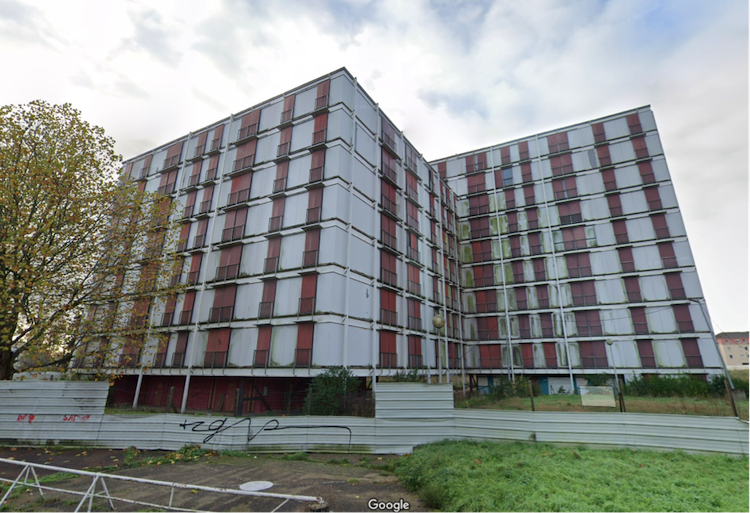Four years after the Lubrizol and Normandie Logistique fires and the scattering of fragments of asbestos roofs in and around Rouen, the total fire and collapse of two disused buildings on Saturday, September 30, 2023 released and projected micro and macro asbestos waste and billions of fibres invisible to the naked eye, carcinogenic to mammalian lungs and clogging fish gills.
 © OlivierCoc. X, night of Saturday, September 30 to Sunday, October 1, 2023
© OlivierCoc. X, night of Saturday, September 30 to Sunday, October 1, 2023
As with the Lubrizol fire, the pollutant plume, soot, ash and asbestos debris spanned the entirety of the Seine and, starting on the left bank, “sprinkled” the right bank and the towns of Bois Guillaume and Mont Saint Aignan. The buildings set on fire were occasionally squatted. They were not physically kept under surveillance by guards who would have been able to prevent incursions or report them in real time to the Rouen Metropolitan police.
At this stage, the death of any illegal occupants cannot be categorically ruled out.
It seems that the owner of the two buildings that burnt down was the property developer COGEDIM, whose plan was to demolish the 7 buildings (after removing asbestos) and build a new residential and commercial district called “le jardin des Pépinières (the nursery garden)”. However, this information has yet to be verified, and it is not certain that the land and financial transaction between Rouen Habitat and COGEDIM was completed before the fire.
The roofs, façades, flockings, insulation, drains and technical pipes were full of asbestos. The buildings were constructed in 1970. The destruction of these buildings has been dragging on since 2018. Delays in the development of the new residential neighbourhood have encouraged the deterioration and sporadic occupation of the out of use buildings.
 © Google Street. November 2022, the two buildings before the fire.
© Google Street. November 2022, the two buildings before the fire.
Google Street photos from 2018 clearly show that the fences preventing access had been vandalised and that the wreckage of a burnt-out car is embedded within the perimeter that is theoretically denied access to.
In the area directly affected by the dust projection and the fallout from the fire, Robin des Bois counted, in Rouen, 5 childcare centres located between 260m and 620m from the epicentre, 4 nursery schools located between 67m and 580m from the epicentre, 3 elementary schools located between 67m and 541m and in Petit-Quevilly, 4 nursery schools located between 719m and 840m, and 2 elementary schools located between 748m and 820m. It should be noted that during the campaign to diagnose sensitive establishments launched in 2012 by the Ministry of Ecology, 3 of these establishments located in Petit-Quevilly were classified in category C: “the diagnoses showed the presence of pollution requiring the implementation of technical management measures, or even the implementation of health measures” (Robert Desnos nursery school, Elsa Triolet nursery school, Louis de Saint-Just elementary school).
Emotions are running high in the affected neighbourhoods. Hundreds of residents call the emergency number to ask for the asbestos debris and soot deposited on balconies and in private gardens to be removed as quickly as possible in accordance with the rules. It goes without saying that the government services will once again play down the health risks of this disaster and try to reassure the neighbouring populations by claiming that the danger thresholds based on existing standards have not been exceeded.
Once again, several tonnes of asbestos will be “invisible” for good, and dioxins, other chlorinated compounds, heavy metals and hydrocarbons produced by the combustion of plastics and other materials used in buildings will be drowned out by the industrial and urban background noise of the Rouen Normandy metropolitan area.
In the Rouen metropolitan area, levels of fine particles (PM10, PM2.5) far exceed the recommendations issued by the World Health Organisation (WHO) to protect human health.
Clearly, this new fire will exacerbate an already critical situation. On site, the thousands of tonnes of rubble and asbestos-coated beams will, for as long as they are not protected from rain and wind, constitute a reservoir of pollutants that will also threaten the groundwater in the major bed of the Seine.
There is no doubt about the loss to biodiversity and the damage inflicted on protected species. The buildings burnt down in the Saint-Julien district were nesting, hunting or transit sites for black redstarts, kestrels and bats, particularly common pipistrelles. During the ecological analysis carried out in the spring of 2021, 20 bird species, including 13 nationally protected species, were recorded in the 7 buildings that were still standing at 6p.m. on September 30 (the time and date of the fire).
 Imprimer cet article
Imprimer cet article









